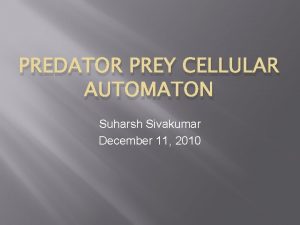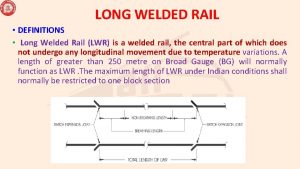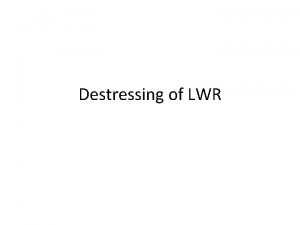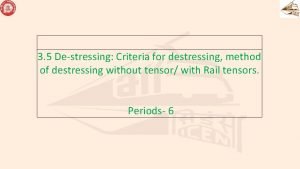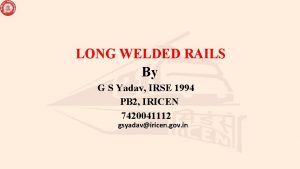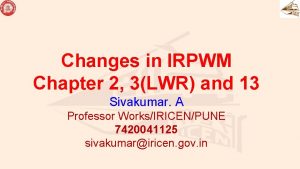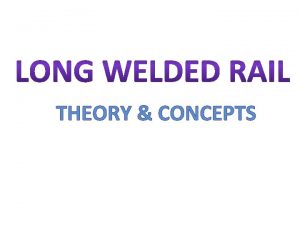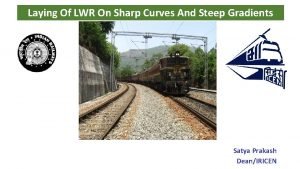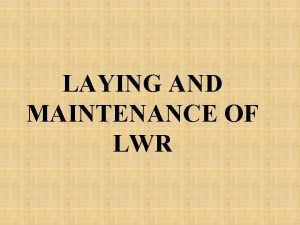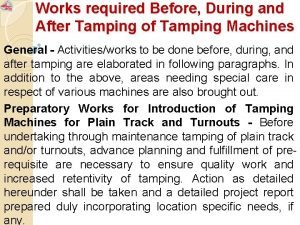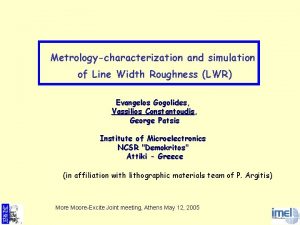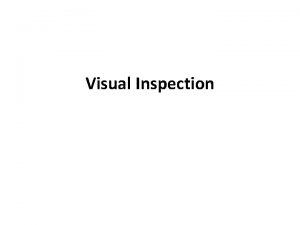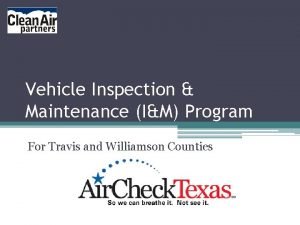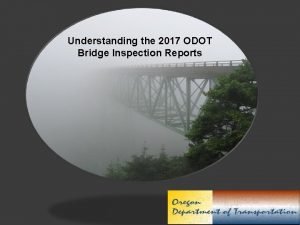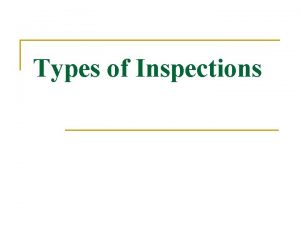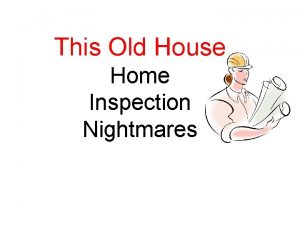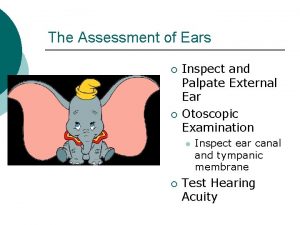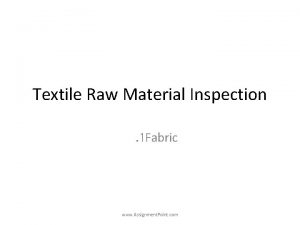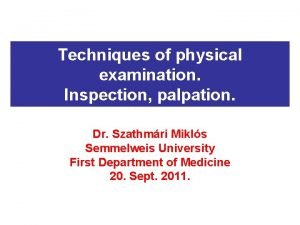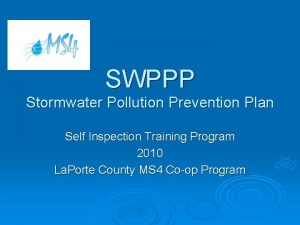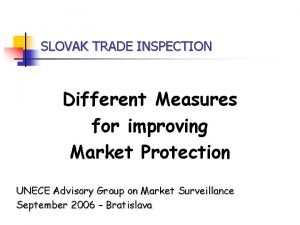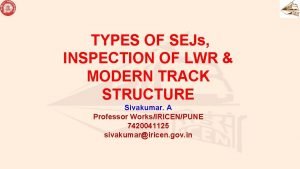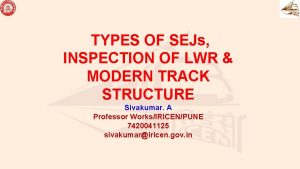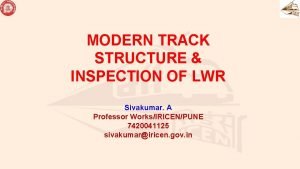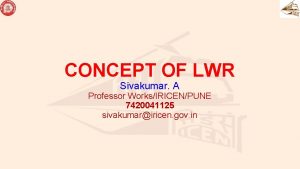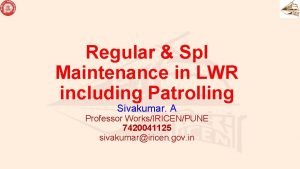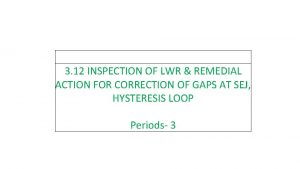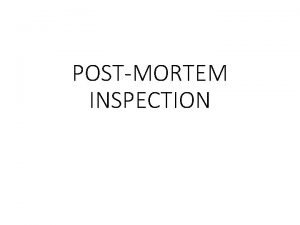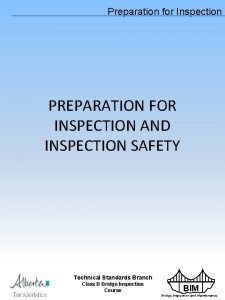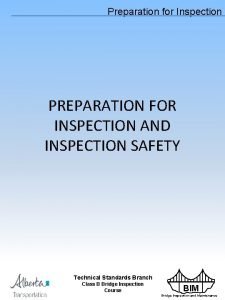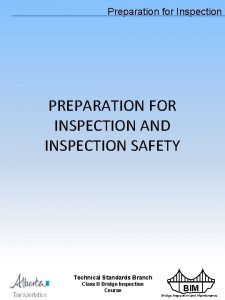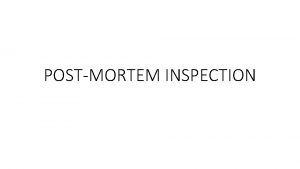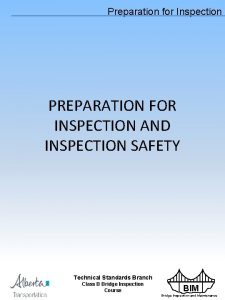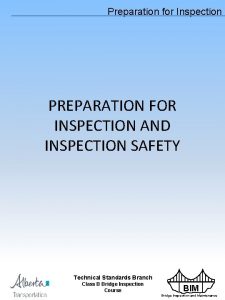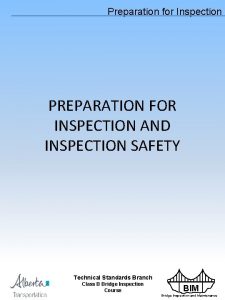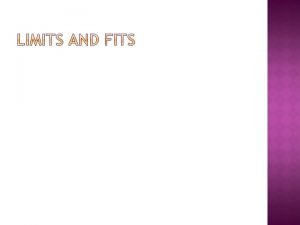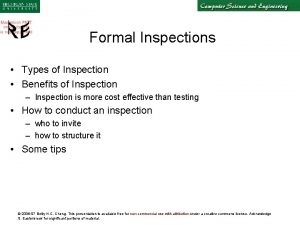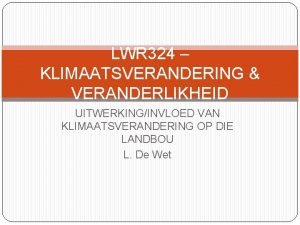TYPES OF SEJs INSPECTION OF LWR Sivakumar A

























- Slides: 25

TYPES OF SEJs & INSPECTION OF LWR Sivakumar. A Professor Works/IRICEN/PUNE 7420041125 sivakumar@iricen. gov. in

What is LWR inspection? (a) SEJ Gap measurement (b) Frequency – 14 times a year? ? (c) Tightness of fittings (d) Zero Missing fittings (e) Oiling and greasing of SEJ (f) Squareness of sleeper at SEJ (g) Movement at centre of LWR / CWR. (h) What else? ? ? Sorry, this is not what is meant by inspection of LWR.

THERMAL FORCES IN RAIL • Temperature changes cause expansion of the rail. If rail is restricted from expansion, thermal forces are built up within the Rail. • The thermal force (P) is calculated by P=EA t where, P = Thermal force in the rail (kg) E = Modulus of elasticity of rail steel (2. 15 x 106 kg/sq. cm) = Coefficient of linear expansion of steel (1. 152 x 10 -5/0 C) A = Area of cross section of the rail (sq. cm) 0 t = Variation of rail temperature from td /to ( C) This Thermal force is resisted by the track structure.

RESISTANCE TO THERMAL FORCE BY TRACK COMPONENTS Resistance by the track (R) is due to • Rails, which are fastened to sleepers with fittings • Sleepers are embedded in Ballast • Ballast is laid on stabilized formation and is well compacted Thus, a track with all its components, acts as a composite structure which offers resistance to the free expansion / contraction of rail on account of thermal forces.

LONG WELDED RAIL Understanding the delicate balance between the Thermal force, P and Resistance offered by the track, R, at all times is the key. INSPECTION OF LWR, HAS TO COVER ALL THESE ASPECTS FOR ITS EFFECTIVE PERFORMANCE.

What are the factors governing P P=EA t Where, the only variable that can be controlled by Engineers is t depends on destressing temperature td and prevailing rail temperature tp td should be within the range as under Temperature Zone I, II&III (ACS – 13) For all rail sections tm to tm+5°C Temperature Zone IV i)52 kg and heavier tm+5°C to tm+10°C II)Other sections tm to tm+5° . t

What are the factors governing P The reliability of t ( td / tp ) depends on thermometer. Para 332 (2) of new IRPWM states “Where a number of thermometers are used to measure the rail temperature at one place, as in case of laying of LWR, de-stressing etc. or during routine tools inspection at office of SSE/ P Way, any of thermometer showing erratic readings, appreciably different from the other adjoining thermometers, shall be considered as defective”.

What are the factors governing P The td of the LWR influences the range of t that a LWR is subjected to Normal Force diagram in a good LWR Disturbed Force diagram in a LWR due to rail fracture.

What are the factors governing P Thus, inspection of LWR, should necessarily include an inspection of rail fracture records, buckling or incipient buckling.

What are the factors governing R Resistance by the track (R) is due to • Rails, which are fastened to sleepers with fittings • Sleepers are embedded in Ballast • Ballast is laid on stabilized formation and is well compacted We need to check, if any past action, has reduced the contribution made by any of the components in reduction in Value of R.

What are the factors governing R Ballast: Most important contributor to track resistance Less ballast Poor Quality of Ballast, Poor consolidation Low Cess, thereby rolling down of Ballast Leads to reduction in R value significantly.

What are the factors governing R Rails: - Wear at rail foot ends Can cause reduction in deflection offered to ERC, Thereby reduction in toe load. This affects adversely the concept of “LWR Track Frame” or “Composite Track Structure” Leading to Creep / differential Creep.

What are the factors governing R Sleepers: any signs of wear in rail seat, crack in sleeper or rounding of sleeper bottom These factors affect Toe load, (Creep) inherent strength of sleeper to hold rail, Poor retentivity of ballast packing.

What are the factors governing R Fittings: Important component to achieve track frame concept ERC: Affects toe load directly (Creep) If not driven correctly, i. e. , if end of central leg not flush with end of insert Liner: If crushed, broken, corroded Missing, placed upside down, displaced etc Leads to reduction in Toe load. (Creep)

What are the factors governing R GRSP: If crushed, missing or displaced out of position RDSO specification for CGRSP, RDSO/M&C/RP-198/2006 for 6. 2 mm and RDSO/M&C/RP-200/2007 for 10 mm CGRSP Harder layer should be kept in contact of Rail. Surface of CGRSP where manufacturer’s initials are embossed should be placed on rail seat, facing up. Otherwise, CGRSP shall lead to premature crushing and Failure at Site (Creep).

What are the factors governing R CREEP The least noticed / considered / monitored factor in a LWR However, probably the most important factor in a LWR A RDSO Study points out that a creep of 50 mm into or out of a LWR segment of 500 M length causes the td to change by about 10° Celsius. Creep post are now available only at centre of LWR and at SEJ, LWR is now from station to station, more variations within this block section length are also available.

CREEP IN LWR 500 m Segment 1 Segment 2 500 m Segment 3 500 m Segment 4 Segment 1 – Creep from both adjoining segments into this segment – if total creep is more than 50 mm, td gets lowered by about 10° Celsius, buckling tendency increases for same book value of td Segment 2 – Creep into and out of this segment is same, thus effective creep is zero, td remains unaltered Segment 3 – Creep from both adjoining segments out of this segment – if total creep is more than 50 mm, td gets increased by about 10° Celsius, rail fracture tendency increases for same book value of td Segment 4 – Creep into and out of this segment is same, thus effective creep is zero, td remains unaltered.

Inspection of LWR requires less maintenance, but intensive inspection at supervisory and officer’s level is required Ballast section shall always be complete. Checked, especially at pedestrian / cattle crossings, curves, approaches of LC, P&C and bridges. Cess level should be correctly maintained. Replenishment of ballast before the onset of summer. Inspection shall be more frequent in the AN during summer Knowledge of staff regarding prescribed maintenance practices checked and the work is done accordingly.

Inspection of LWR USFD examination of rails should not be in arrears. Defective rails/welds should be replaced expeditiously. Inspections of gaps at SEJ and creep/movement at central portion of LWR/CWR by Permanent Way officials would be done as per prescribed schedule by JE/SSE (P. Way) Subsection, SSE (P. Way) I/C and ADEN. Check for creep in as many locations as possible. If creep posts are not available, creep indication on liner seat can be a tell-tale help to identify creep. During TRR / TSR, & Service, Complete & Effective Fitting (ZMF? ) to be aimed at and achieved.

IRS Design SEJ T-4160, 4165 Note: - The Reference line shall be kept 20 mm from Central bolt of CI Chair At the time of Destressing / Initial Laying, the tip of TR should coincide with the mid point of central bolt to CI Chair

Imp. SEJ T-6902 & T-6914 – Single Gap, 80 mm Note: - The Reference line shall be kept 20 mm from Central bolt of CI Chair At the time of Destressing / Initial Laying, the tip of TR should coincide with the mid point of central bolt to CI Chair

Imp. SEJ T-6622 & T-6930 – Double Gap, 65 mm Note: - The Reference line shall be kept 20 mm from Central bolt of CI Chair At the time of Destressing / Initial Laying, the tip of TR should coincide with the mid point of central bolt to CI Chair

Inspection of LWR Inspections of gaps at SEJ and creep/movement at centre of LWR/CWR by Permanent Way officials as per following schedule: i) SSE-In-charge/SSE Sub-section: - (ACS 15) a) Every fortnight during two coldest & two hottest months of year at about min and max temperatures alternately by SSE In-charge and SSE Sub-section. b) Alternately once in two months during other months of the year. ii) Assistant Engineer: At least once in six months, preferably during coldest and hottest months.

Inspection of LWR Important Points to be Noted: • • • The gap shall always mean distance between reference line to the tip of stock rail / Tongue rail. In case of DG design, 2 reference marks shall be erected at site Sleeper spacing at SEJ shall be ensured, 700 mm for Conventional SEJ, 600 mm for SG and DG ALWAYS REMEMBER THE DELICATE BALANCE BETWEEN P and R.

THANKS
 Suharsh sivakumar
Suharsh sivakumar Harijah sivakumar
Harijah sivakumar Long welded rail
Long welded rail Destressing of rail temperature
Destressing of rail temperature Destressing of rail temperature
Destressing of rail temperature Breathing length of rail
Breathing length of rail Rdso drawing rt-8527
Rdso drawing rt-8527 Buffer rail in lwr
Buffer rail in lwr Steep grade sharp curves
Steep grade sharp curves Difference between lwr and cwr
Difference between lwr and cwr Ballast profile for lwr track double line
Ballast profile for lwr track double line Line width roughness
Line width roughness Limitations of visual inspection
Limitations of visual inspection Unsafe
Unsafe Aircheck texas inspection
Aircheck texas inspection Odot bridge inspection manual
Odot bridge inspection manual Nnn inspection
Nnn inspection This old house inspection nightmares
This old house inspection nightmares Ohsc inspection tools
Ohsc inspection tools External ear
External ear Textile raw
Textile raw Heavy equipment safety checklist
Heavy equipment safety checklist Inspection and palpation
Inspection and palpation Swppp inspection training
Swppp inspection training Ssl inspection gdpr
Ssl inspection gdpr Slovak trade inspection
Slovak trade inspection
